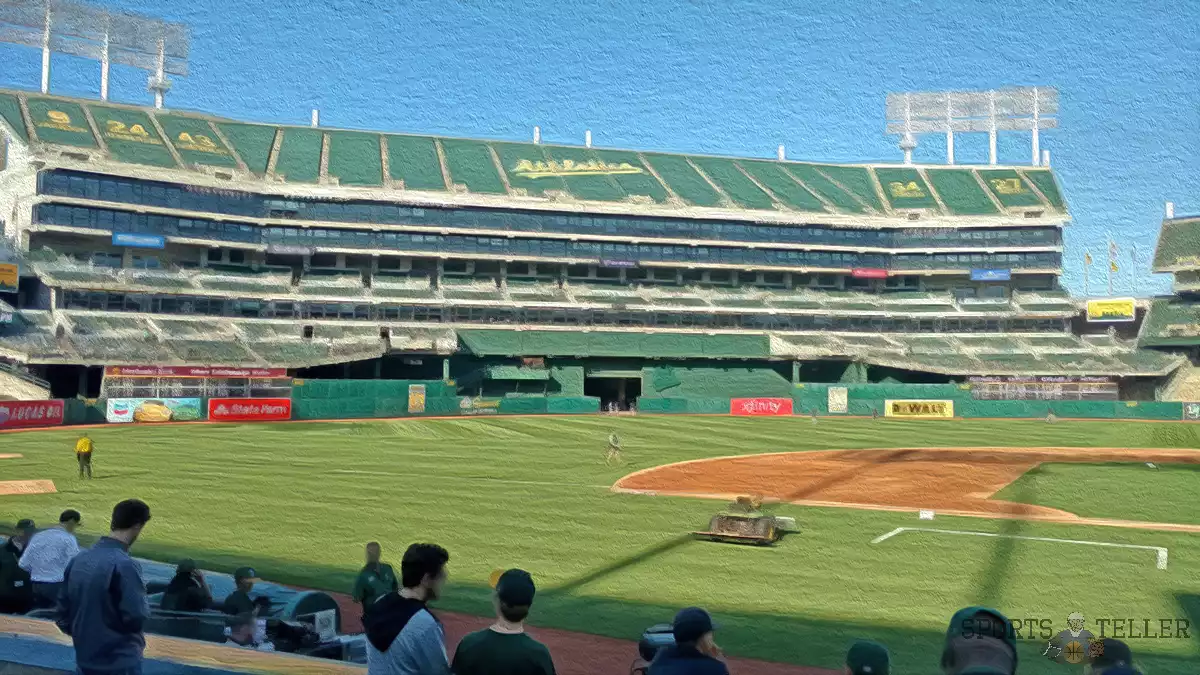Which of the 10 Never Seen Facts on RingCentral Coliseum Oakland Will Impress You the Most? The 10 Facts on RingCentral Coliseum are…
Hello Everyone! Welcome to Sports Teller! Today, we will be going over the latest news on 10 Never Seen Facts on RingCentral Coliseum! Without further adieu, let’s begin!
10 Never Seen Facts on RingCentral Coliseum
RingCentral Coliseum is one of the league’s oldest west coast stadiums every sports fan has on their bucket list. In fact, the Athletics venue opened in 1968 and hosted the All-Star Game in 1987. Any Oakland fan that bleeds Athletics green and yellow will know every information possible, from the team winning the 1989 World Series to Bob Melvin claiming the Manager of the Year in 2018. However, there are new RingCentral Coliseum facts that many baseball supporters never knew or never heard of in their lives. For details on what facts baseball fans rarely knew about, please refer to 10 Never Seen Facts on RingCentral Coliseum below!
10: Before the Kansas City Athletics, the Cleveland Indians were Considered for Oakland
The Athletics’ run in Oakland is pretty much the most successful one for the franchise. The men in green have won four World Series championships, including three straight from 1972 until 1974. Perhaps the most memorable Fall Classic victory the A’s ever achieved was in 1989 against crosstown rival San Francisco Giants (despite the earthquake). However, the Athletics as a franchise had a long road to get to Oakland in the first place. To clarify, they began their club history as the Philadelphia Athletics before moving to Kansas City to become the same identity. After just 12 years in Missouri, the baseball club relocated to Oakland in 1968, where they reside today.
But did you know that the Cleveland Indians were considered for relocation to Oakland before the Athletics? In the mid-1960s, the Ohio ballclub was looking for a new home since they were playing in the old Cleveland Municipal Stadium. Then, an Oakland group made an offer to acquire the Indians and move them to California. However, Cleveland turned down the $6.5 million offer and played at their stadium until the 1990s. Meanwhile, the Athletics relocated to Oakland and Kansas City received an expansion club in the Royals.
9: Oakland Coliseum Nearly Lost the Athletics to Denver in the Late 1970s
Over the last couple years, there has been a lot of talk about whether the Athletics would relocate or not. The baseball team was focusing on securing a new ballpark on the Howard Terminal port site. Also, the Athletics were looking into the possibility of moving to Las Vegas if the new stadium deal had fallen through. But believe it or not, this is not the first time that the A’s have had to face a possible relocation in their history. During the late 1970s, the Athletics were losing popularity at the multi-use Coliseum.
They have been struggling to get back to the playoffs despite being several years off of a three-peat dynasty from the mid-1970s. Anyway, then-Athletics owner Charlie Finley was ready to sell the underperforming franchise to another party. Finley initially sold the team to oil businessman Marvin Davis, who planned on moving them to Denver. However, the sale was rejected by the city of Oakland due to lease restrictions. Finley eventually sold the club to a local jeans firm owner (Walter Haas II) and the Athletics remained in California. On the other hand, Denver received the Rockies as an expansion franchise in 1993.
8: San Jose Earthquakes used to Play Select Games at the Athletics Stadium
It is 100% normal that baseball stadiums can host other events that have nothing to do with the sport itself. Most notably, the Coliseum served as the home for the Raiders football team until their relocation to Las Vegas. In addition, the stadium hosted lots of live music shows dating back to the 1970s. Perhaps the rarest moment to occur at the now-RingCentral Coliseum was soccer matches. More specifically, the San Jose Earthquakes of Major League Soccer played a couple games there during the late 2000s.
Beginning in 2008, the Earthquakes made their debut at the Oakland Coliseum. The main purpose for San Jose to play games at the Athletics venue was to play big rivalry contests in front of a higher capacity. Also, the Earthquakes were playing in the aging and outdated Buck Shaw Stadium. One example of the soccer squad’s rivalry game was against in-state opponent LA Galaxy. The Earthquakes would play a couple more games at the Coliseum until they moved to their new venue: Avaya Stadium (now PayPal Park).
7: The Mount Davis Upper Seats Have Not Been Open Since 2006
Mount Davis is one of the RingCentral Coliseum’s most interesting features for Athletics fans and baseball spectators to see. It is actually the name for the 300 level outfield seats facing home plate. Mount Davis was named after the late Raiders owner Al Davis, not the former A’s slugger Khris Davis or fan favorite Rajai Davis. The most famous part about Mount Davis is that its tarp coverings feature the retired Athletics numbers along with the huge team name in the center.
For those who don’t know, the Mount Davis seats have not been open to the public since 2006. The inspiration behind this decision was to make the Athletics games feel more like a baseball stadium. Another factor was that the A’s had not been successful in the playoffs as they had not won a series since 1990. Also, the Athletics were in a time where they were sharing the same venue with the Raiders football team. However, there is an expectation of the tarp rule on Mount Davis. Oakland stated that the tarps would only come off if the A’s make it to the Fall Classic.
On a traditional note, sports teams usually have their own lockers located at stadiums nationwide. In fact, those locker rooms are located far away from each other to prevent possible brawls and sign stealing. Inside a normal locker room, the area consists of the following: television sets, showers, refrigerators, and player lockers. But sometimes, uncontrollable circumstances can lead to both teams having to share the same locker room. Well, that’s what happened following the Athletics game in the 2010s.
In June 2013, the A’s just defeated their division rival Seattle Mariners in a blowout 10-2. Both teams were looking forward to getting cleaned up and ready for the next day. Suddenly, the water pipes on the ground level suffered a breakage and created a flood of stenched water. Therefore, the Athletics and Mariners had no choice but to share the same locker room. Where exactly? Both clubs found an empty players’ room located on the second floor. This is not the first time a baseball stadium was impacted by sewage on game day as Kauffman Stadium went through a delay due to a huge leakage in the right field bullpen.
10 Never Seen Facts on Oracle Park San Francisco
10 Never Seen Facts on T-Mobile Park Seattle
10 Never Seen Facts on Angel Stadium Anaheim
5: The Athletics Venue was one of the Last Multi-Use Baseball Stadiums to Still Exist in the 2000s
Since the 21st century began, multi-purpose open-air stadiums were starting to fade away. In fact, baseball teams were building retro-style ballparks along with other features such as two-level bullpens and 360 concourses. Examples of those retro-style stadiums are Camden Yards, PNC Park, and Progressive Field. Meanwhile, cookie-cutter stadiums were starting to disappear due to football teams getting their own facilities. But Interestingly, RingCentral Coliseum was one of the last multi-use baseball stadiums to still exist in the 2000s.
With the Athletics ballpark the only baseball venue in a football stadium in the country, it was previously joined by the now-Hard Rock Stadium. The Marlins used to play at the Dolphins facility until they relocated to their downtown ballpark in 2012. In addition, the Phillies formerly shared home games with the Eagles at Veterans Stadium before they moved to Citizens Bank Park. Three Rivers Stadium (Pirates/Steelers) lasted until 2001, while Riverfront Stadium (Reds/Bengals) existed before the 2003 season. Last but not least, Candlestick Park was torn down in the 2010s after serving as the home for both the Giants and the 49ers.
4: The Right Field Cheering Section is Unlike Any Other in the Big Leagues
Usually, baseball fans and sports spectators in general would come to the stadium to root for their team. They would cheer loudly if their player hit a home run and heckle if there was a bench-clearing brawl. But in the rarest of times, ballparks have a designated cheering section located in a specific seating area. For example, T-Mobile Park in Seattle previously had a King’s Court section on the 3rd base side dedicated to RHP Felix Hernandez. Also, Yankee Stadium has the Bleacher Creatures in the outfield that call out each New York players’ names in the 1st inning.
Fortunately, for the Athletics, they have a right field cheering section unlike any other in the big leagues. Officially referred to as the FANily (fan and family in one word), they would play music whenever the Athletics were winning or losing. For instance, they would play the drumline-style drums every time the A’s were at-bat. Another example is that cheering section members would wave huge flags to get fans motivated for game action. No matter if it’s a packed house or low attendance numbers, the FANily will always be at the Oakland Coliseum to support their beloved Athletics.
3: Oakland Coliseum was the Site for Led Zeppelin’s Final Concert in the USA
Basically, it is a nice practice for MLB facilities to host large-scale performances. In fact, there are teams that previously hosted live music shows. Those teams were the following: Mariners, Mets, Guardians, Red Sox, Reds, Blue Jays, Dodgers, Tigers, Pirates, and many more. Concerts can vary with either a post-game event or just a stand alone performance during the off-season. But did you know that the Oakland Coliseum was the site for Led Zeppelin’s final concert in the USA? And that doesn’t count singing at National Anthems or having themed nights.
In July 1977, British rock band Led Zeppelin performed in what appeared to be their final live concert in the country. In fact, they played some of their hit songs like “Stairway to Heaven” and Whole Lotta Love.” Unfortunately, things have turned for the worse for Led Zeppelin since that Oakland show. When frontman Robert Plant’s son died suddenly, the band canceled the remainder of the 1977 tour dates. Most notably, drummer John Bonham’s untimely death resulted in the disbandment of Led Zeppelin. The rock band did, however, reunite for a one-off show in 2007.
2: Athletics Park is 1 of 5 Active Stadiums to Have Both a No-Hitter and Perfect Game
RingCentral Coliseum has hosted a lot of unique baseball moments since it opened in the late 1960s. For example, the Athletics won the 1989 World Series and reached the Championship Series in 2006. In addition, the stadium hosted six playoff appearances and three division titles since 2012. The Oakland Coliseum also witnessed Khris Davis hitting 40 or more home runs in a season from 2016 until 2018. However, the A’s are looking to win a postseason series for the first time since 2006. But believe it or not, RingCentral Coliseum is one of five active MLB ballparks to host both a perfect game and a no-hitter.
In 2010, Athletics Right-Hander Dallas Braden threw a perfect game on Mother’s Day against the Rays. During the stadium’s inaugural season in 1968, the late Catfish Hunter pitched a contest without giving up any hits or base runners vs. Twins. In 2018, Southpaw Sean Manaea tossed a no-hitter against the eventual World Series champion Red Sox. By the way, here are the other ballparks that saw both a no-hitter and a perfect game: Dodger Stadium, Oracle Park, T-Mobile Park, and Guaranteed Rate Field.
1: Oakland Coliseum has a Special Day Dedicated to Root Beer Once a Year
Whenever a spectator goes to a baseball game in the summer, he or she would expect some fan-related experiences. To clarify, ballparks would offer fan giveaways like player bobbleheads or even Hawaiian shirts. Also, baseball teams would provide post-game fireworks on select nights and weekends. Perhaps the most significant part of the game-day experience is the food offerings at concession stands. Speaking of food, Oakland Coliseum has a special day dedicated to root beer once a year.
Root Beer Float Day is a fan promotion that takes place every summer during the season. Located in the Eastside Club at left field (club level), there are dozens and dozens of tables where fans can buy their own mugs and receive root beer floats. The most exciting part about this event is that those drinks are served by local law enforcement officials along with players and broadcasters from the Athletics, San Jose Sharks, and Golden State Warriors. For those who are wondering, all money proceeds will go towards the A’s Community Fund.
Thanks for reading! We hope this article helped! Please feel free to read our other articles and follow us on Twitter and Facebook for more!




